An Evaluation of Public Spaces with the Use of Direct and Remote Methods
Abstract
1. Introduction
2. Materials and Methods
2.1. Research Procedure
2.2. Study Objects
2.3. Selection and Inventory of Public Spaces
2.4. Direct Approach to Evaluating the Quality of Public Spaces
- -
- “+’’ for elements whose quality exceeds basic criteria,
- -
- “0” for elements whose quality meets basic criteria,
- -
- “-” for elements whose quality is below basic criteria.
- -
- “NA”—elements that were not identified in the analyzed public spaces.
2.5. Remote Approach to Evaluating the Quality of Public Spaces
3. Results
3.1. Inventory Results
3.2. The Results of Public Space Evaluation in the Direct and the Remote Approach
4. Discussion
5. Summary and Conclusions
Author Contributions
Funding
Conflicts of Interest
References
- Banerjee, T. The future of public space. Beyond invented streets and reinvented places. J. Am. Plan. Assoc. 2001, 67, 9–24. [Google Scholar] [CrossRef]
- Pasaogullari, N.; Doratli, N. Measuring accessibility and utilization of public spaces in Famagusta. Cities 2004, 21, 225–232. [Google Scholar] [CrossRef]
- Gehl, J. Life between Buildings: Using Public Space; Island Press: Washington, DC, USA, 2011. [Google Scholar]
- Francis, J.; Giles-Corti, B.; Wood, L.; Knuiman, M. Creating sense of community: The role of public space. J. Environ. Psychol. 2012, 32, 401–409. [Google Scholar] [CrossRef]
- Francis, J.; Wood, L.J.; Knuiman, M.; Giles-Corti, B. Quality or quantity? Exploring the relationship between Public Open Space attributes and mental health in Perth, Western Australia. Soc. Sci. Med. 2012, 74, 1570–1577. [Google Scholar] [CrossRef] [PubMed]
- Stanley, B.W.; Stark, B.L.; Johnston, K.L.; Smith, M.E. Urban open spaces in historical perspective: A transdisciplinary typology and analysis. Urban Geogr. 2012, 33, 1089–1117. [Google Scholar] [CrossRef]
- Koohsari, M.J.; Mavoa, S.; Villanueva, K.; Sugiyama, T.; Badland, H.; Kaczynski, A.T.; Giles-Corti, B. Public open space, physical activity, urban design and public health: Concepts, methods and research agenda. Health Place 2015, 33, 75–82. [Google Scholar] [CrossRef] [PubMed]
- Hadavi, S.; Kaplan, R. Neighborhood satisfaction and use patterns in urban public outdoor spaces: Multidimensionality and two-way relationships. Urban For. Urban Green. 2016, 16, 110–122. [Google Scholar]
- Koohsari, M.J.; Badland, H.; Mavoa, S.; Villanueva, K.; Francis, J.; Hooper, P.; Owen, N.; Giles-Corti, B. Are public open space attributes associated with walking and depression? Cities 2018, 74, 119–125. [Google Scholar] [CrossRef]
- Altman, I.; Zube, H. Public places and spaces; Springer: New York, NY, USA; Plenum Press: London, UK, 1989; Volume 10. [Google Scholar]
- Stanilov, K. Taking stock of post-socialist urban development: A recapitulation. In The Post-Socialist City: Urban Form and Space Transformations in Central and Eastern Europe after Socialism; Stanilov, K., Ed.; Springer Science & Business Media: Dodrecht, The Netherlands, 2007; Volume 92. [Google Scholar]
- Madanipour, A. Public spaces of European cities. Nord. Arkit. 2005, 1, 7–16. [Google Scholar]
- Low, S.; Smith, N. (Eds.) The Politics of Public Space; Routledge: London, UK, 2013. [Google Scholar]
- Magalhães, C.D.; Carmona, M. Innovations in the management of public space: Reshaping and refocusing governance. Plan. Theory Pract. 2006, 7, 289–303. [Google Scholar] [CrossRef]
- Carmona, M.; De Magalhaes, C.; Hammond, L. Public Space: The Management Dimension; Routledge: London, UK, 2008. [Google Scholar]
- Beck, H. Linking the quality of public spaces to quality of life. J. Place Manag. Dev. 2009, 2, 240–248. [Google Scholar] [CrossRef]
- Doratli, N. Revitalizing historic urban quarters: A model for determining the most relevant strategic approach. Eur. Plan. Stud. 2005, 13, 749–772. [Google Scholar] [CrossRef]
- Soule, J. Urbanization and cultural conservation—A summary of policies and tools in the United States. In Managing Historic Cities World Heritage Papers; UNESCO: Paris, France, 2010; Volume 27, pp. 73–81. [Google Scholar]
- Szirmai, V. Socially sustainable urban development in the historic urban centres of East Central Europe. Discuss. Pap. 2006, 20–38. [Google Scholar]
- Carmona, M. Contemporary public space, part two: Classification. J. Urban Des. 2010, 15, 157–173. [Google Scholar] [CrossRef]
- Kochanowska, D. Przestrzeń publiczna—Kluczowy element miasta współczesnego—Zintegrowana czy podzielona. In Problemy Kształtowania Przestrzeni Publicznych; Lorens, P., Martyniuk-Pęczek, J., Eds.; Wydawnictwo Urbanista: Gdańsk, Poland, 2010. [Google Scholar]
- Bravo, D. The Flaneurs surprise, lessons from the European prize for urban public space 2000–2010. In Favour of Public Space. Ten Years of the European Prize for Urban Public Space; Centre de Cultura Contemporania de Barcelona and ACTAR: Barcelona, Spain, 2010; pp. 44–47. [Google Scholar]
- Carmona, M. Contemporary public space: Critique and classification, part one: Critique. J. Urban Des. 2010, 15, 123–148. [Google Scholar] [CrossRef]
- Nissen, S. Urban transformation from public and private space to spaces of hybrid character. Czech Sociol. Rev. 2008, 6, 1129–1149. [Google Scholar] [CrossRef]
- Lorens, P. Theming urban spaces in post-socialist cities. In Proceedings of the 47th ISOCARP Congress, Wuhan, China, 24–28 October 2011. ISOCARP Paper Platform. [Google Scholar]
- Lam, K.C.; Ng, S.L.; Hui, W.C.; Chan, P.K. Environmental quality of urban parks and open spaces in Hong Kong. Environ. Monit. Assess. 2005, 111, 55–73. [Google Scholar] [CrossRef] [PubMed]
- Ter, Ü. Quality criteria of urban parks: The case of Alaaddın Hill (Konya-Turkey). Afr. J. Agric. Res. 2011, 6, 5367–5376. [Google Scholar]
- Chang, H.S.; Liao, C.H. Exploring an integrated method for measuring the relative spatial equity in public facilities in the context of urban parks. Cities 2011, 28, 361–371. [Google Scholar] [CrossRef]
- Arnberberg, A. Urban densification and recreational quality of public urban green spaces—A Viennese case study. Sustainability 2012, 4, 703–720. [Google Scholar] [CrossRef]
- Brambilla, G.; Gallo, V.; Zambon, G. The soundscape quality in some urban parks in Milan, Italy. Int. J. Environ. Res. Public Health 2013, 10, 2348–2369. [Google Scholar] [CrossRef] [PubMed]
- Franco, S.F.; Macdonald, J.L. Measurement and valuation of urban greenness: Remote sensing and hedonic applications to Lisbon, Portugal. Reg. Sci. Urban Econ. 2018, 72, 156–180. [Google Scholar] [CrossRef]
- Senetra, A.; Krzywnicka, I.; Mielke, M. An analysis of the spatial distribution, influence and quality of urban green space—A case study of the Polish city of Tczew. Bull. Geogr. Socio Econ. Ser. 2018, 42, 129–149. [Google Scholar] [CrossRef]
- van Melik, R.G. Changing public space. The recent redevelopment of Dutch city squares. In Netherlands Geographical Studies; Utrecht University: Utrecht, The Netherlands, 2008; p. 373. [Google Scholar]
- Mehta, V. The street: A quintessential social public space. Routledge: The role of public space. J. Environ. Psychol. 2013, 32, 401–409. [Google Scholar]
- Oranratmanee, R.; Sachakul. Streets as public spaces in Southeast Asia: Case studies of Thai pedestrian streets. J. Urban Des. 2014, 19, 211–229. [Google Scholar] [CrossRef]
- Carr, S.; Stephen, C.; Francis, M.; Rivlin, L.G.; Stone, A.M. Public Space; Cambridge University Press: Cambridge, UK, 1992. [Google Scholar]
- Taylor, B.T.; Fernando, P.; Bauman, A.E.; Williamson, A.; Craig, J.C.; Redman, S. Measuring the quality of public open space using Google Earth. Am. J. Prev. Med. 2011, 40, 105–112. [Google Scholar] [CrossRef] [PubMed]
- Timperio, A.; Ball, K.; Salmon, J.; Roberts, R.; Crawford, D. Is availability of public open space equitable across areas? Health Place 2007, 13, 335–340. [Google Scholar] [CrossRef]
- Yang, P.P.J.; Putra, S.Y.; Li, W. Viewsphere: A GIS-based 3D visibility analysis for urban design evaluation. Environ. Plan. B Plan. Des. 2007, 34, 971–992. [Google Scholar] [CrossRef]
- Mavoa, S.; Koohsari, M.J.; Badland, H.M.; Davern, M.; Feng, X.; Astell-Burt, T.; Giles-Corti, B. Area-Level disparities of public open space: A geographic information systems analysis in metropolitan Melbourne. Urban Policy Res. 2015, 33, 306–323. [Google Scholar] [CrossRef]
- Siregar, J.P. Assessment of public space quality using good public space index (case study of Merjosari Sub District, Municipality of Malang, Indonesia). Procedia Soc. Behav. Sci. 2014, 135, 10–17. [Google Scholar] [CrossRef][Green Version]
- Hurtubia, R.; Guevara, A.; Donoso, P. Using images to measure qualitative attributes of public spaces through SP surveys. Transp. Res. Procedia 2015, 11, 460–474. [Google Scholar] [CrossRef]
- Abbasi, A.; Alalouch Ch Bramley, G. Open space quality in deprived urban areas: User perspective and use pattern. Procedia Soc. Behav. Sci. 2016, 216, 194–205. [Google Scholar] [CrossRef]
- Szczepańska, A.; Pietrzyk, K. An evaluation of public spaces in historical centers of small towns—Case study. J. Urban Plan. Dev. 2019, 146, 1–12. [Google Scholar] [CrossRef]
- Kothencz, G.; Blaschke, T. Urban parks: Visitors’ perceptions versus spatial indicators. Land Use Policy 2017, 64, 233–244. [Google Scholar] [CrossRef]
- Dębniewska, M.; Wojtowicz, K. Finansowanie działalności turystycznej na obszarach przyrodniczo cennych w regionie Warmii i Mazur. Ekon. Śr 2016, 1, 129–142. [Google Scholar]
- Environmental Impact Assessment of the Strategy for the Socioeconomic Development of the Region of Warmia and Mazury until 2025; Funderko Korbel, Krok-Baściuk Sp. J.: Warsaw, Poland, 2013.
- Strategy for the Socioeconomic Development of the Region of Warmia and Mazury until 2025; Executive Board of the Region of Warmia and Mazury: Olsztyn, Poland, 2013.
- Morąg Town Council. Abridged Historical and Urban Development Study, Conservation Guidelines for Morąg; Morąg Town Council: Morąg, Poland, 1993. [Google Scholar]
- Romasiuk, I.; Fikus-Wójcik, A.; Jaskulska, M.; Piszczek, A.; Rodzewicz, A.; Rościszewska, M.; Turzyński, M.; Podolska, W. A Study of Municipal Public Spaces—Workshop 2014. An Evaluation of the Attractiveness of Public Spaces; Biuro Rozwoju Gdańska: Gdańska, Poland, 2014. [Google Scholar]
- Natland, J. Urban by Design: An Evaluation of Public Spaces in Downtown New Westminster. Ph.D. Thesis, Simon Fraser University, Burnaby, BC, Canada, 2007. [Google Scholar]
- Dymitrow, M. The effigy of urbanity or a rural parody? A visual approach to small-town public space. J. Cult. Geogr. 2014, 31, 1–31. [Google Scholar] [CrossRef]
- Cafuta, M. Open space evaluation methodology and three dimensional evaluation model as a base for sustainable development tracking. Sustainability 2015, 7, 13690–13712. [Google Scholar] [CrossRef]
- Karacor, E.; Akcam, E. Comparative analysis of the quality perception in public spaces of Duzce City. Curr. Urban Stud. 2016, 4, 257–266. [Google Scholar] [CrossRef]
- Wojnarowska, A. Model for assessment of public space quality in town centers. Eur. Spat. Res. Policy 2016, 23, 81–109. [Google Scholar] [CrossRef]
- Szczepańska, A.; Pietrzyk, K. A multidimensional analysis of spatial order in public spaces: A case study of the town Morąg, Poland. Bull. Geogr. Socio Econ. Ser. 2019, 44, 115–129. [Google Scholar] [CrossRef]
- United Nations. A/RES/70/1, Transforming Our World: The 2030 Agenda for Sustainable Development; ONZ, General Assembly, Resolution Adopted by the General Assembly on 25 September 2015; United Nations: New York, NY, USA, 2015.
- United Nations. New urban agenda, United Nations. In Proceedings of the United Nations Conference on Housing and Sustainable Urban Development, Habitat III, Quito, Ecuador, 17–20 October 2016. [Google Scholar]
- Urban agenda for the EU, pact of Amsterdam. In Proceedings of the Informal Meeting of EU Ministers Responsible for Urban Matters on 30 May 2016 in Amsterdam, Amsterdam, The Netherlands, 30 May 2016.
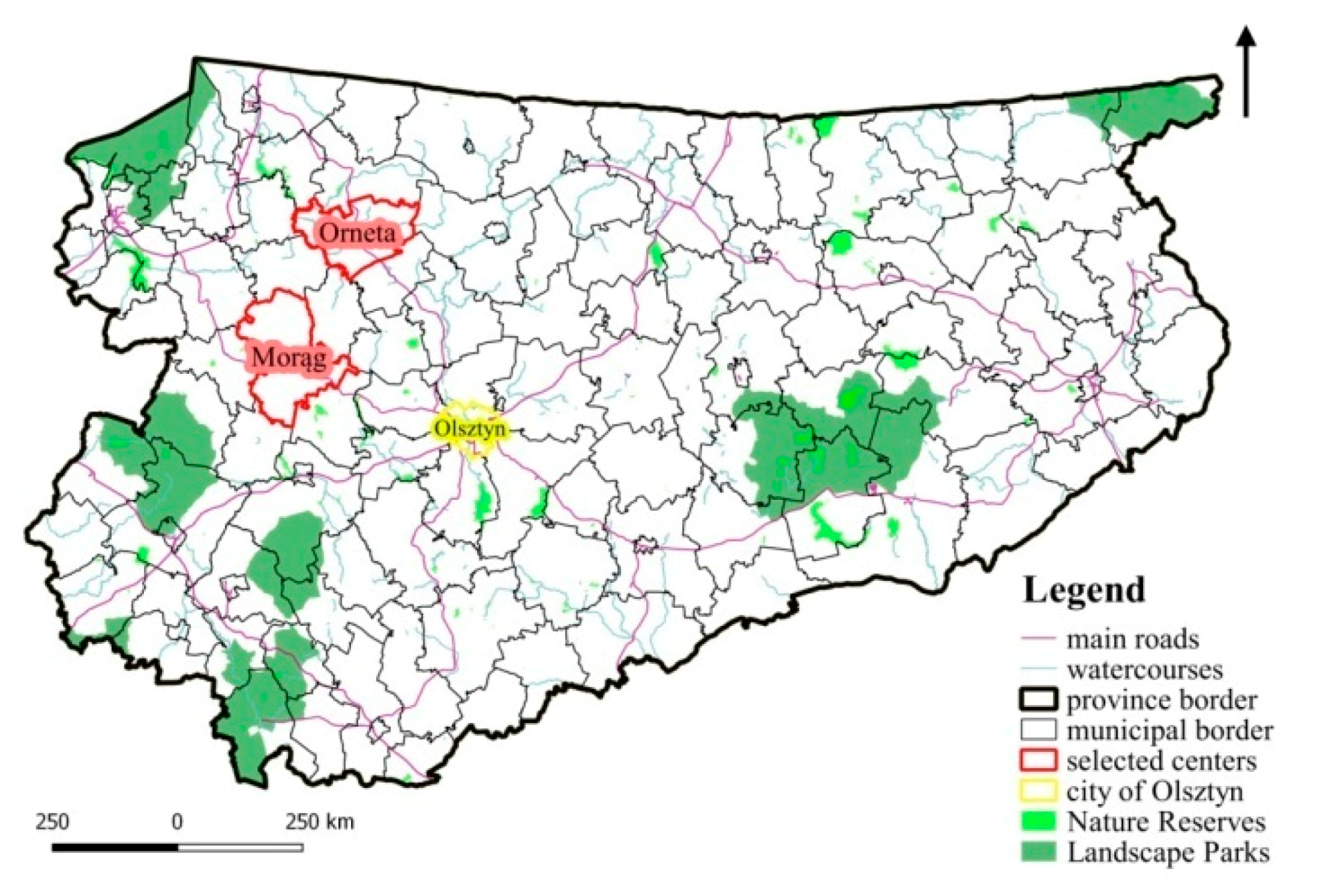
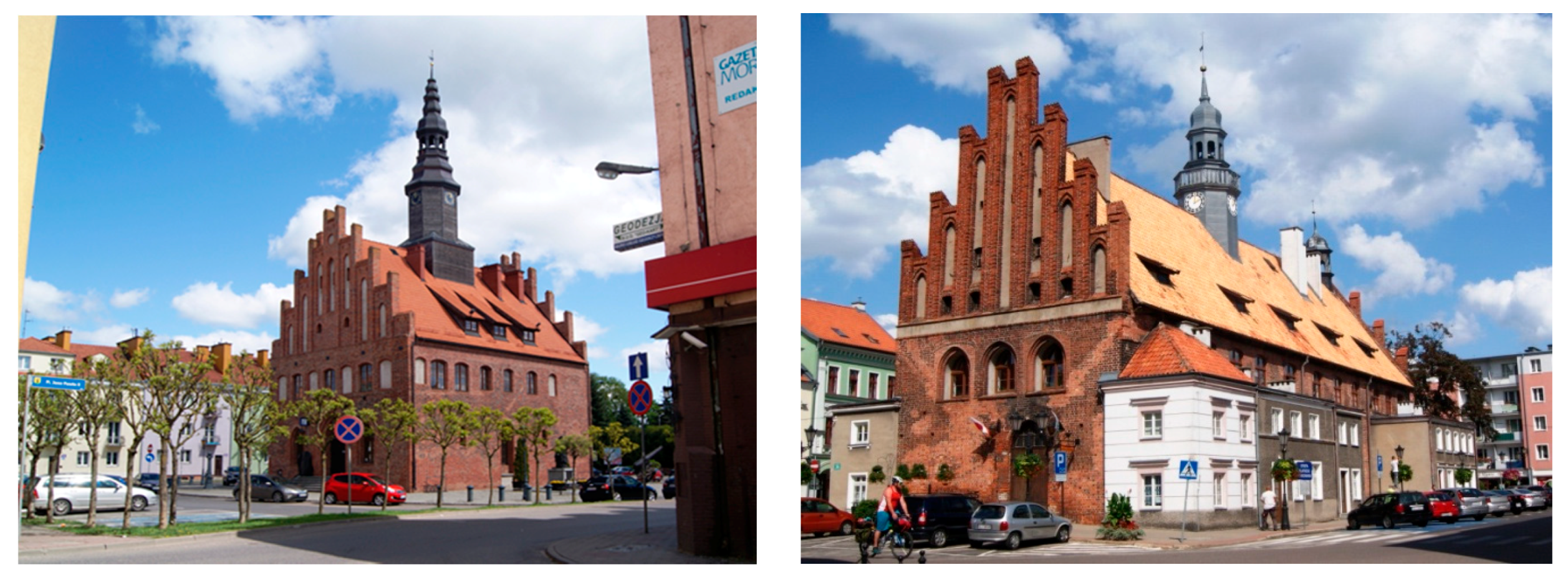
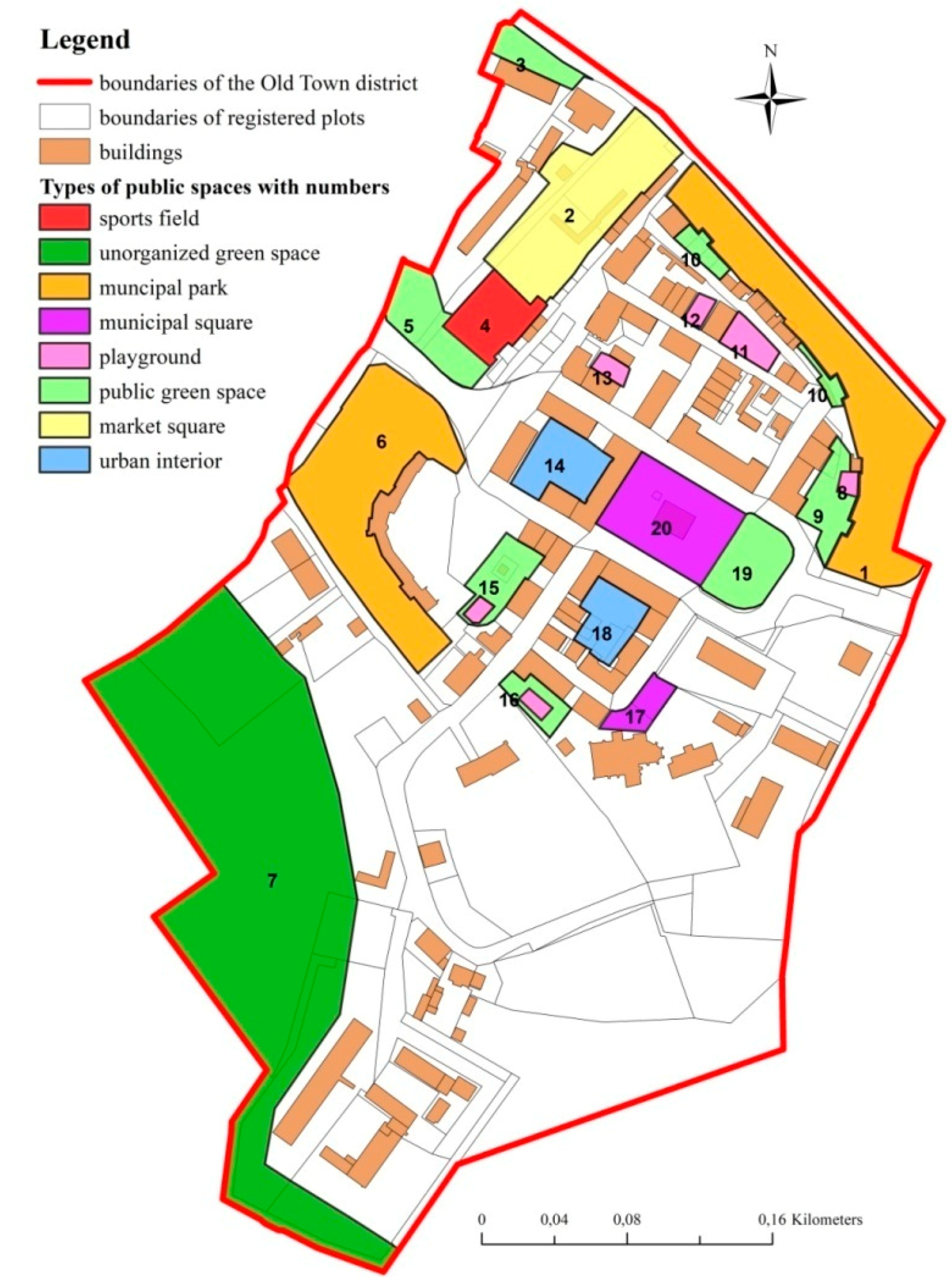
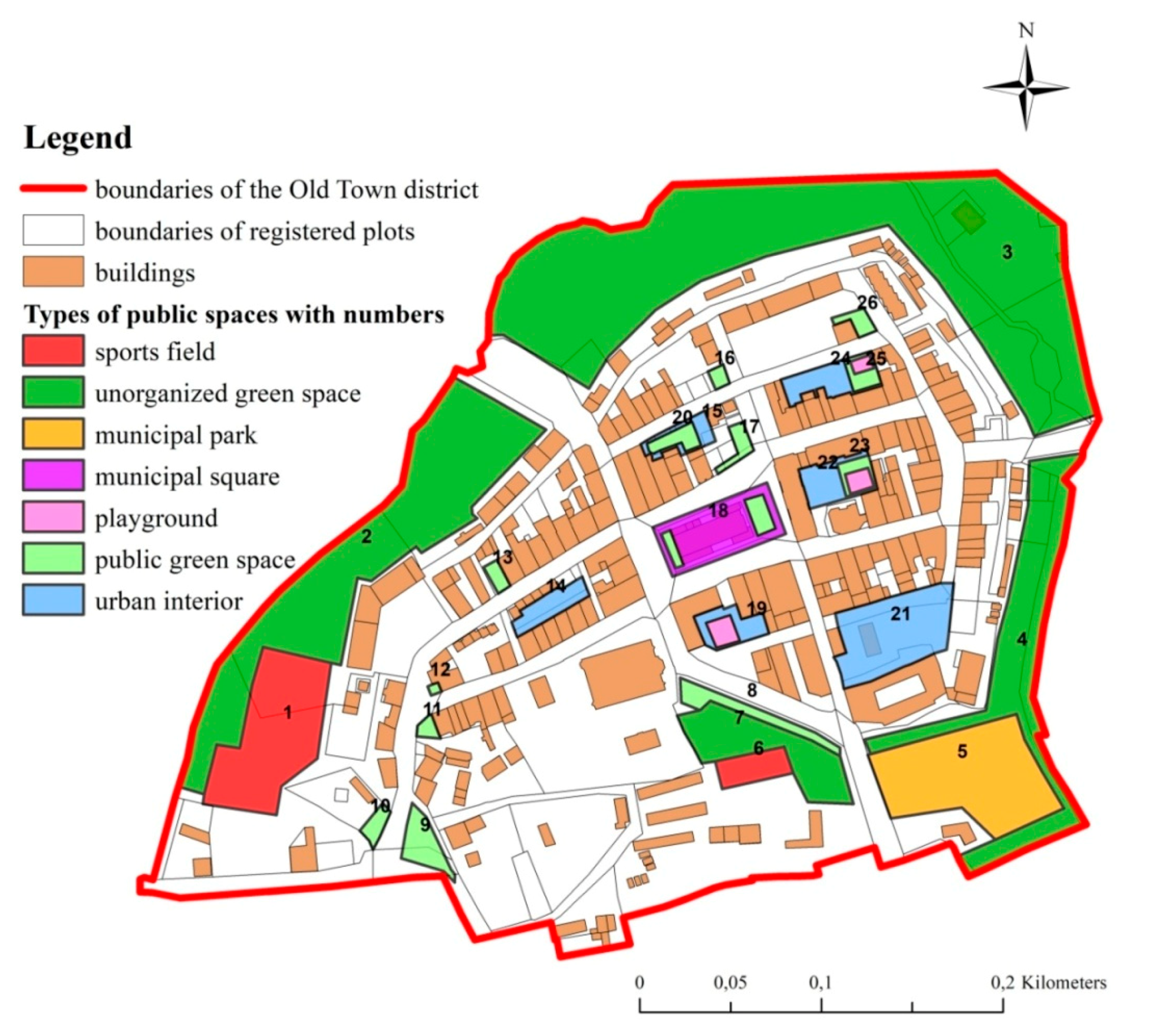
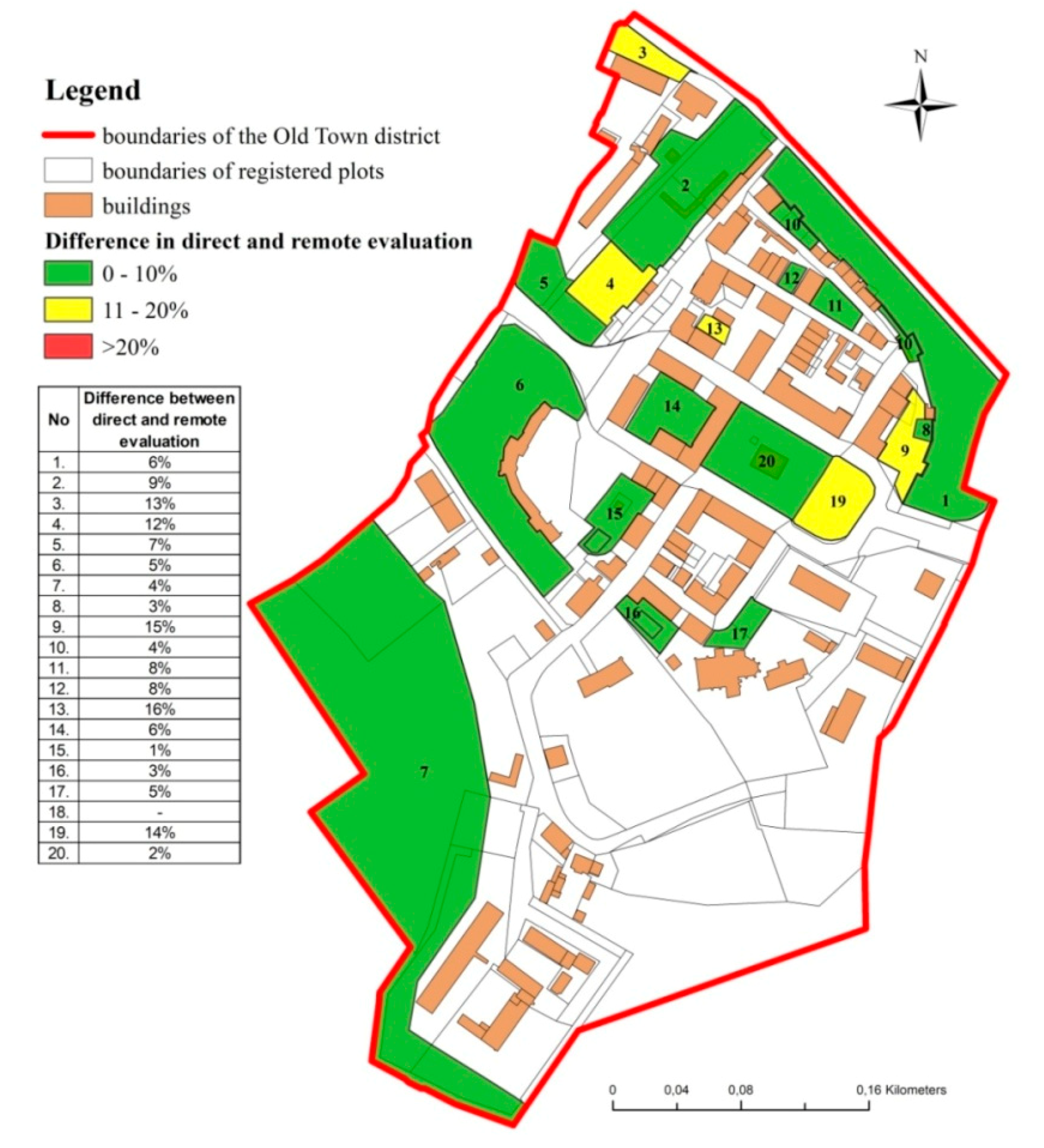
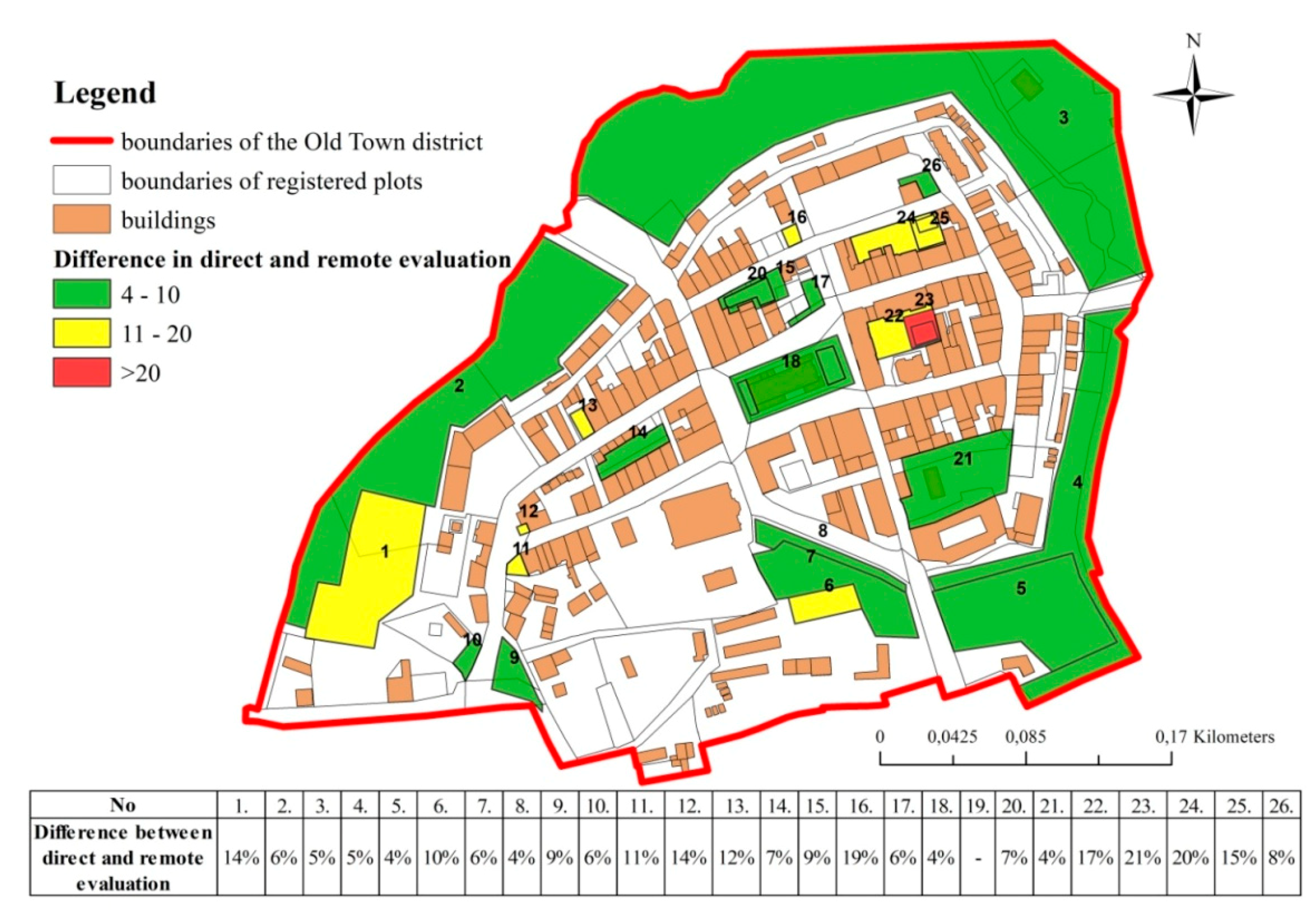
| Spatial Order | Components | Rated Elements |
|---|---|---|
| Architectural | General proportions, urban morphology, urban planning, craftsmanship and style, additional features, green spaces | 1. adequate surface parameters, 2. adequate height parameters, 3. adequate distance between spaces with different functions, 4. urban planning solutions, 5. roofs and canopies, 6. sitting areas (quantity), 7. sitting areas (quality), 8. trash cans, 9. garbage containers, 10. lighting (quantity and quality), 11. playground facilities, 12. tables, 13. laundry drying facilities, 14. carpet beating frames, 15. garages, coal sheds, 16. services, 17. residential buildings, 18. quality of pedestrian surfaces, 19. recreational areas, 20. safety, 21. style, 22. architectural and historical monuments, 23. green spaces—cohesion, 24. green spaces—proportional design, 25. shade producing trees |
| Esthetic | Display of information, advertising and signs, facades, roofs, pavement and fencing, color scheme, cleanliness | 1. availability and maintenance of public information signs (traffic signs, information boards on buildings), 2. non-organized advertising and organized advertising, 3. signboards, 4. facades—maintenance, 5. roofs—maintenance, 6. paved surfaces—maintenance, 7. fences—maintenance, 8. pavement materials, 9. fencing materials, 10. facade color, 11. roof color, 12. pavement color, 13. fence color, 14. general cleanliness, 15. cleanliness of buildings and public facilities, 16. cleanliness in public green spaces |
| Social | Users, atmosphere, access to other public spaces, safety, lighting, surveillance | 1. number of users, 2. social and demographic structure, 3. atmosphere—subjective evaluation, 4. availability of public spaces within a 100 m radius, 5. ratio of male to female users, 6. subjective evaluation of safety, 7. lighting, 8. surveillance |
| Environmental | Noise, green spaces | 1. noise levels, 2. greenery |
| Functional | Footpaths and bike paths, rhythm and harmony, accessibility | 1. width of sidewalks, 2. disabled access, 3. bike paths, 4. obstacles to pedestrian traffic, 5. unconstrained flow of traffic, traffic safety, 6. harmonious space, 7. car parks, 8. intensity of vehicular traffic, 9. subjective evaluation of the entire space |
| Type of Public Space | Number of Public Spaces—Morąg | Number of Public Spaces—Orneta |
|---|---|---|
| Historical municipal park | 1 | - |
| Municipal park/green space | - | 1 |
| Municipal park | 1 | - |
| Sports field | 1 | 2 |
| Market square | 1 | - |
| Public green space | 5 | 10 |
| Unorganized green space | 1 | 4 |
| Playground | 4 | - |
| Playground with public green space | 2 | 2 |
| Municipal square | 2 | - |
| Municipal square with public green space | - | 1 |
| Urban interior | 2 | 5 |
| Urban interior with playground | - | 1 |
| Total | 20 | 26 |
| No. | Public Space | Percentage of Components | |||||||
|---|---|---|---|---|---|---|---|---|---|
| Direct Approach | Remote Approach | Direct Approach | Remote Approach | Direct Approach | Remote Approach | Direct Approach | Remote Approach | ||
| Quality Exceeds Basic Criteria | Quality Meets Basic Criteria | Quality below Basic Criteria | Not Identified | ||||||
| 1. | Historical municipal park | 32% | 26% | 16% | 19% | 30% | 38% | 22% | 17% |
| 2. | Market square | 12% | 2% | 18% | 11% | 62% | 72% | 8% | 15% |
| 3. | Public green space | 37% | 21% | 32% | 23% | 15% | 32% | 16% | 24% |
| 4. | Sports field | 8% | 11% | 17% | 4% | 60% | 49% | 15% | 36% |
| 5. | Public green space | 38% | 34% | 30% | 21% | 10% | 13% | 22% | 32% |
| 6. | Municipal park | 18% | 23% | 32% | 36% | 38% | 30% | 12% | 11% |
| 7. | Unorganized green space | 5% | 0% | 5% | 9% | 67% | 70% | 23% | 21% |
| 8. | Playground | 25% | 21% | 28% | 26% | 35% | 38% | 12% | 15% |
| 9. | Public green space | 52% | 23% | 20% | 28% | 16% | 36% | 12% | 13% |
| 10. | Public green space | 10% | 4% | 3% | 4% | 83% | 81% | 4% | 11% |
| 11. | Playground | 12% | 4% | 5% | 11% | 60% | 70% | 23% | 15% |
| 12. | Playground | 10% | 4% | 12% | 2% | 65% | 81% | 13% | 13% |
| 13. | Playground | 15% | 2% | 23% | 4% | 50% | 79% | 12% | 15% |
| 14. | Urban interior | 35% | 28% | 22% | 28% | 40% | 36% | 3% | 8% |
| 15. | Playground with public green space | 27% | 28% | 22% | 23% | 38% | 38% | 13% | 11% |
| 16. | Playground with public green space | 17% | 13% | 25% | 23% | 52% | 53% | 6% | 11% |
| 17. | Municipal square | 75% | 68% | 2% | 6% | 12% | 9% | 11% | 17% |
| 18. | Urban interior | 28% | - | 23% | - | 45% | - | 4% | - |
| 19. | Public green space | 63% | 38% | 3% | 19% | 13% | 11% | 21% | 32% |
| 20. | Municipal square | 58% | 62% | 15% | 15% | 15% | 15% | 12% | 8% |
| No | Public Space | Percentage of Components | |||||||
|---|---|---|---|---|---|---|---|---|---|
| Direct Approach | Remote Approach | Direct Approach | Remote Approach | Direct Approach | Remote Approach | Direct Approach | Remote Approach | ||
| Quality Exceeds Basic Criteria | Quality Meets Basic Criteria | Quality below Basic Criteria | Not Identified | ||||||
| 1. | Sports field | 10% | 19% | 3% | 11% | 53% | 26% | 34% | 44% |
| 2. | Unorganized green space | 8% | 17% | 15% | 17% | 53% | 43% | 24% | 23% |
| 3. | Unorganized green space | 7% | 15% | 12% | 4% | 57% | 55% | 24% | 26% |
| 4. | Unorganized green space | 7% | 13% | 15% | 11% | 60% | 64% | 18% | 12% |
| 5. | Municipal park (under construction)/green space | 10% | 11% | 7% | 6% | 58% | 64% | 25% | 19% |
| 6. | Sports field | 3% | 13% | 3% | 6% | 64% | 45% | 30% | 36% |
| 7. | Unorganized green space | 8% | 11% | 10% | 6% | 52% | 45% | 30% | 38% |
| 8. | Public green space | 43% | 49% | 13% | 15% | 16% | 9% | 28% | 27% |
| 9. | Public green space | 32% | 45% | 32% | 21% | 16% | 9% | 20% | 25% |
| 10. | Public green space | 27% | 26% | 30% | 19% | 30% | 38% | 13% | 17% |
| 11. | Public green space | 20% | 34% | 17% | 13% | 50% | 32% | 13% | 21% |
| 12. | Public green space | 20% | 4% | 23% | 11% | 43% | 68% | 14% | 17% |
| 13. | Public green space | 30% | 47% | 18% | 6% | 38% | 26% | 14% | 21% |
| 14. | Urban interior | 10% | 2% | 10% | 6% | 73% | 86% | 7% | 6% |
| 15. | Urban interior | 10% | 28% | 33% | 32% | 55% | 38% | 2% | 2% |
| 16. | Public green space | 30% | 6% | 25% | 11% | 37% | 68% | 8% | 15% |
| 17. | Public green space | 20% | 15% | 18% | 11% | 48% | 55% | 14% | 19% |
| 18. | Municipal square with public green space | 32% | 36% | 17% | 17% | 38% | 30% | 13% | 17% |
| 19. | Urban interior with playground | 58% | - | 15% | - | 22% | - | 5% | - |
| 20. | Public green space | 25% | 36% | 22% | 19% | 42% | 32% | 11% | 13% |
| 21. | Urban interior | 12% | 13% | 12% | 19% | 74% | 66% | 2% | 2% |
| 22. | Urban interior | 23% | 55% | 33% | 26% | 38% | 11% | 6% | 8% |
| 23. | Playground with public green space | 15% | 49% | 32% | 13% | 31% | 8% | 22% | 30% |
| 24. | Urban interior | 18% | 57% | 48% | 15% | 32% | 26% | 2% | 2% |
| 25. | Playground with public green space | 27% | 53% | 33% | 13% | 30% | 21% | 10% | 13% |
| 26. | Public green space | 17% | 21% | 18% | 6% | 52% | 49% | 13% | 24% |
| No. | Public Space | Percentage of Elements with Identical Scores in the Direct and the Remote Approach | Percentage of Elements with Different Scores in the Direct and the Remote Approach |
|---|---|---|---|
| 1. | Historical municipal park | 40% | 60% |
| 2. | Market square | 53% | 47% |
| 3. | Public green space | 48% | 52% |
| 4. | Sports field | 40% | 60% |
| 5. | Public green space | 52% | 48% |
| 6. | Municipal park | 47% | 53% |
| 7. | Unorganized green space | 56% | 44% |
| 8. | Playground | 47% | 53% |
| 9. | Public green space | 35% | 65% |
| 10. | Public green space | 65% | 35% |
| 11. | Playground | 50% | 50% |
| 12. | Playground | 60% | 40% |
| 13. | Playground | 44% | 56% |
| 14. | Urban interior | 52% | 48% |
| 15. | Playground with public green space | 47% | 53% |
| 16. | Playground with public green space | 48% | 52% |
| 17. | Municipal square | 63% | 37% |
| 18. | Urban interior | - | - |
| 19. | Public green space | 53% | 47% |
| 20. | Municipal square | 58% | 42% |
| Mean | 50% | 50% | |
| Standard deviation | 8% | 8% |
| No. | Public Space | Percentage of Elements with Identical Scores in the Direct and the Remote Approach | Percentage of Elements with Different Scores in the Direct and the Remote Approach |
|---|---|---|---|
| 1. | Sports field | 63% | 37% |
| 2. | Unorganized green space | 63% | 37% |
| 3. | Unorganized green space | 62% | 38% |
| 4. | Unorganized green space | 53% | 47% |
| 5. | Municipal park (under construction)/green space | 58% | 42% |
| 6. | Sports field | 67% | 33% |
| 7. | Unorganized green space | 62% | 38% |
| 8. | Public green space | 60% | 40% |
| 9. | Public green space | 63% | 37% |
| 10. | Public green space | 57% | 43% |
| 11. | Public green space | 52% | 48% |
| 12. | Public green space | 55% | 45% |
| 13. | Public green space | 57% | 43% |
| 14. | Urban interior | 72% | 28% |
| 15. | Urban interior | 48% | 52% |
| 16. | Public green space | 48% | 52% |
| 17. | Public green space | 67% | 33% |
| 18. | Municipal square with public green space | 67% | 33% |
| 19. | Urban interior with playground | - | - |
| 20. | Public green space | 55% | 45% |
| 21. | Urban interior | 67% | 33% |
| 22. | Urban interior | 38% | 62% |
| 23. | Playground with public green space | 43% | 57% |
| 24. | Urban interior | 43% | 57% |
| 25. | Playground with public green space | 50% | 50% |
| 26. | Public green space | 55% | 45% |
| Mean | 57% | 43% | |
| Standard deviation | 9% | 9% |
Publisher’s Note: MDPI stays neutral with regard to jurisdictional claims in published maps and institutional affiliations. |
© 2020 by the authors. Licensee MDPI, Basel, Switzerland. This article is an open access article distributed under the terms and conditions of the Creative Commons Attribution (CC BY) license (http://creativecommons.org/licenses/by/4.0/).
Share and Cite
Szczepańska, A.; Pietrzyk, K. An Evaluation of Public Spaces with the Use of Direct and Remote Methods. Land 2020, 9, 419. https://doi.org/10.3390/land9110419
Szczepańska A, Pietrzyk K. An Evaluation of Public Spaces with the Use of Direct and Remote Methods. Land. 2020; 9(11):419. https://doi.org/10.3390/land9110419
Chicago/Turabian StyleSzczepańska, Agnieszka, and Katarzyna Pietrzyk. 2020. "An Evaluation of Public Spaces with the Use of Direct and Remote Methods" Land 9, no. 11: 419. https://doi.org/10.3390/land9110419
APA StyleSzczepańska, A., & Pietrzyk, K. (2020). An Evaluation of Public Spaces with the Use of Direct and Remote Methods. Land, 9(11), 419. https://doi.org/10.3390/land9110419






